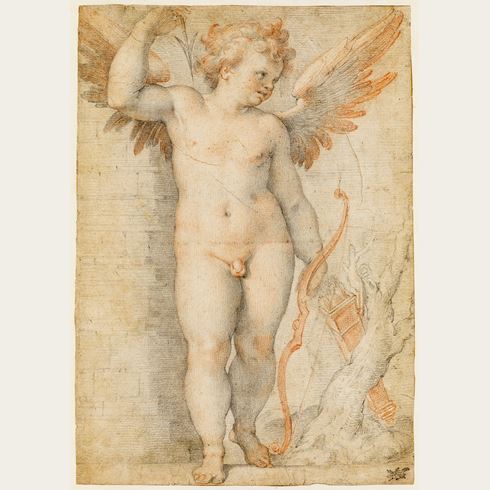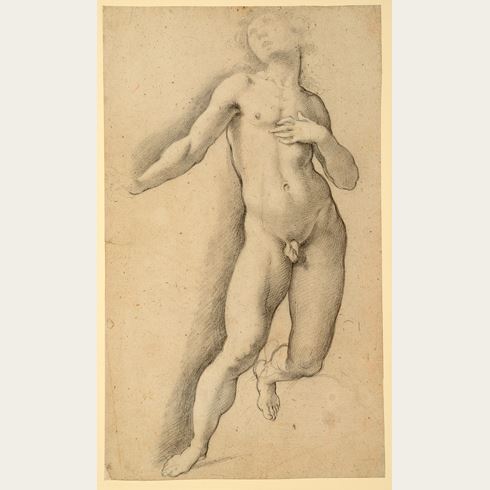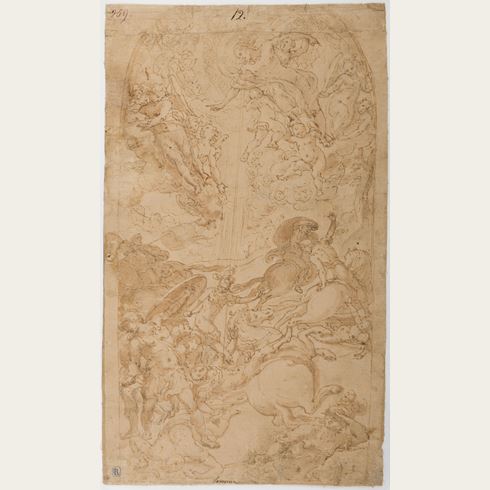Cristoforo RONCALLI
(Pomarance 1552 - Rome 1626)
The Virgin and Child with Saint Anne
Sold
Black chalk, heightened with touches of white chalk, on two joined sheets of paper, laid down.
Made up at the top right and lower right corners.
319 x 389 mm. (12 5/8 x 15 3/8 in.)
Made up at the top right and lower right corners.
319 x 389 mm. (12 5/8 x 15 3/8 in.)
This large and impressive sheet is drawn on two sheets of paper, with the sheet containing the figure of Saint Anne carefully joined at the left onto the sheet with the Virgin and Child. This would suggest that the artist may have originally intended the composition to include another figure, instead of Saint Anne, or that the figure of the saint was considerably altered from its original conception. The handling of black chalk and the extensive shading with hatched lines in the background are characteristic features of Roncalli’s draughtsmanship.
Although unrelated to any surviving painting or fresco by the artist, this drawing may, on stylistic grounds, be dated to the very end of the 16th century or the early years of the 17th century. The physiognomy of the Virgin and the voluminous draperies are typical features of Roncalli’s work of this period, as seen in such paintings as The Madonna and Child with Saints in the Roman church of San Gregorio al Celio, painted between 1602 and 1603, or the fresco of The Flight into Egypt in the sanctuary at Loreto, painted between 1605 and 1609. An increase in the size and monumentality of the figures in Roncalli’s paintings, as well as in the preparatory drawings for them, becomes evident around 1600.
Among stylistically comparable drawings in black chalk by Roncalli are a study of The Visitation in the British Museum and a group of four drawings of the Fathers of the Church in the collection of the Dukes of Devonshire at Chatsworth.
Although unrelated to any surviving painting or fresco by the artist, this drawing may, on stylistic grounds, be dated to the very end of the 16th century or the early years of the 17th century. The physiognomy of the Virgin and the voluminous draperies are typical features of Roncalli’s work of this period, as seen in such paintings as The Madonna and Child with Saints in the Roman church of San Gregorio al Celio, painted between 1602 and 1603, or the fresco of The Flight into Egypt in the sanctuary at Loreto, painted between 1605 and 1609. An increase in the size and monumentality of the figures in Roncalli’s paintings, as well as in the preparatory drawings for them, becomes evident around 1600.
Among stylistically comparable drawings in black chalk by Roncalli are a study of The Visitation in the British Museum and a group of four drawings of the Fathers of the Church in the collection of the Dukes of Devonshire at Chatsworth.
Little is known of Cristoforo Roncalli’s artistic training. Known as Il Pomarancio after his birthplace of Pomarance, he is first documented working in Siena between 1576 and 1579. During this period he painted an altarpiece for the Duomo and collaborated on the decoration of a family palazzo, and also received a commission for an altarpiece intended for the church of SS. Apostoli in Florence. Roncalli then settled in Rome, where he is recorded by 1582, and was active there for the remainder of his career. He was associated with a circle of artists active in the city that included his compatriot Niccolò Circignani (confusingly also known as Il Pomarancio) as well as Cavaliere d’Arpino, Cesare Nebbia and Paris Nogari. Roncalli received numerous public and private commissions, and was admitted to the Accademia di San Luca in 1588.
He earned a reputation as an ecclesiastic mural painter of the first rank, gaining the patronage of such Roman families as the Crescenzi, Mattei and Giustiniani, and working in the churches of Santa Maria in Aracoeli, San Giovanni Decollato, Santa Maria in Vallicella and San Silvestro in Capite in Rome. Between 1599 and 1604 he supervised the decoration of the Cappella Clementina in St. Peter’s for Pope Clement VIII, and also worked for the Pope on the decoration of the transept of San Giovanni in Laterano. Around 1607 Roncalli was named a cavaliere di christo by Pope Paul V, shortly after receiving the most significant commission of his career; the fresco decoration of the sacristy and cupola of the Basilica of the Santa Casa at Loreto, on which he worked between 1605 and 1615. On his return to Rome, Roncalli spent the last decade of his career working on more modest commissions.
An exceptional draughtsman, Roncalli worked for the most part in both black and red chalk, switching easily between them for both compositional and figural studies, although using the former slightly more in the 1580’s and 1590’s. (While a number of pen drawings by the artist are known, after the 1580’s he seems to have worked almost exclusively in chalk.) His earliest datable drawings – studies for works of the late 1570’s, as well as copies after Raphael - already show a mastery of form and line and a sophistication that would be characteristic of the artist’s drawings throughout his career. The largest extant group of drawings by Roncalli is today in the Uffizi.
Provenance
Possibly Charles Grey, Colchester and thence by descent to James Round, Little Birch
The Round family, Colchester
Their sale, Colchester, Bonham’s, 1 April 1954 (according to a note formerly attached to the old mount).

 Cristoforo-RONCALLI-TheVirginandChildwithSaintAnne-1862014T184748.jpg?width=1900&height=1900&mode=max&qlt=80&format=jpeg)
 Cristoforo-RONCALLI-TheVirginandChildwithSaintAnne-1862014T184748.jpg?width=155&height=300&qlt=80&format=jpg&mode=max)




